Utility Transformer DC Bias Caused by Metro Stray Current—A Review
Abstract
1. Introduction
2. Stray Current and Its Impact
3. Mechanism and Impact of DC Bias on Utility Transformers
- S (x, y) is the stray current distribution at the point (x, y);
- IS is the stray current;
- (xs, ys) is the position of the stray current source;
- σ is the standard deviation, controlling the spread of the distribution.
4. Suppression Measures for DC Bias
4.1. DC-Blocking Methods
4.2. DC-Limiting Methods
4.3. Combined DC-Limiting–DC-Blocking Method
4.4. Reverse DC Injection Method
5. Challenges and Future Directions
- In-depth study of the possible coupling mechanism of stray current in the metro with the utility transformer and its specific DC bias influence on the transformer;
- Developing the modeling and evaluation methods to predict and quantify the risk of utility transformer DC bias more accurately;
- Implementation of advanced monitoring systems for assessing the real-time DC levels, facilitating timely interventions, and improving system safety;
- Investigating more cost-effective solutions that maintain high reliability and performance;
- Establishing a standardized criterion and optimizing transformer design to evaluate the effectiveness of future suppression technologies.
6. Conclusions
Author Contributions
Funding
Data Availability Statement
Conflicts of Interest
References
- Ma, Y.; Bhatt, N.R.; Wu, Q.; Pokharel, M. Urban rail transit in heritage-rich cities: Exploring the unique project risks. Eng. Constr. Archit. Manag. 2025. [Google Scholar] [CrossRef]
- Wei, Y.; Yang, X.; Xiao, X.; Ma, Z.; Zhu, T.; Dou, F.; Wu, J.; Chen, A.; Gao, Z. Understanding the Resilience of Urban Rail Transit: Concepts, Reviews, and Trends. Engineering 2024, 41, 7–18. [Google Scholar] [CrossRef]
- Xue, X.; Zhang, Y.; Zhang, L.; Wang, Y.; Hou, R.; Ni, T. Evaluation on Sustainable Development of Smart Urban Rail Transit. Mob. Inf. Syst. 2022, 2022, 1–10. [Google Scholar] [CrossRef]
- Cao, Y.; Xiao, S.; Yan, J.; Liu, C.; Li, T.; Liu, X.; Wu, G.; Guo, Y.; Hou, J.; He, Y.; et al. Contribution analysis of neutral current for the substations invaded by stray current from multiple metro lines. Int. J. Electr. Power Energy Syst. 2025, 169, 110773. [Google Scholar] [CrossRef]
- Cao, Z. Integrating Station-Area Development with Rail Transit Networks: Lessons from Japan Railway in Tokyo. Urban Rail Transit 2022, 8, 167–174. [Google Scholar] [CrossRef]
- Dodds, R. A case study from a utility [DC traction stray current control]. In Proceedings of the IEE Seminar on DC Traction Stray Current Control—Offer a Stray a Good Ohm, London, UK, 21 October 1999. [Google Scholar]
- Lu, K.; Zhang, L.; Li, S.; Huang, Y.; Ding, X.; Hao, J.; Huang, S.; Li, X.; Lu, F.; Zhang, H. Urban Rail Transit in China: Progress Report and Analysis (2015–2023). Urban Rail Transit 2024, 1–27. [Google Scholar] [CrossRef]
- Chen, Y.; Li, Z.; Dong, W.; Zhao, H.; Ye, S. Influences of Rail Transit Station on Temporal-spatial Distribution Patterns of Surrounding Service Industry: Fuzhou Metro Line 1 Case. J. Subtrop. Resour. Environ. 2021, 16, 77–88. [Google Scholar]
- Lin, J.; Zheng, Y.; Yang, Z.; Zhan, J.; Jin, L.; Li, C. Influence of Metro Stray Current on Transformer Operation in Zhejiang Power Grid and the Control Measures. Zhejiang Electr. Power 2021, 40, 6. [Google Scholar]
- Wang, C.; Li, W.; Wang, Y.; Xu, S.; Fan, M. Stray Current Distributing Model in the Subway System: A review and outlook. Int. J. Electrochem. Sci. 2018, 13, 1700–1727. [Google Scholar] [CrossRef]
- Bhagat, S.; Yang, X.; Wang, M.; Mariscotti, A. Review and Evaluation of Stray Current Mitigation for Urban Rail Transit. Trans. China Electrotech. Soc. 2021, 36, 4851–4863. [Google Scholar]
- Wang, C.; Qin, G. Corrosion of underground infrastructures under metro-induced stray current: A review. Corros. Commun. 2024, 14, 23–38. [Google Scholar] [CrossRef]
- Aatif, S.; Hu, H.; Rafiq, F.; He, Z. Analysis of rail potential and stray current in MVDC railway electrification system. Railw. Eng. Sci. 2021, 29, 394–407. [Google Scholar] [CrossRef]
- Zaboli, A.; Vahidi, B. Stray Current and Rail Potential Control Strategies in Electric Railway Systems. In Transportation Electrification: Breakthroughs in Electrified Vehicles, Aircraft, Rolling Stock, and Watercraft; Wiley: Hoboken, NJ, USA, 2022; pp. 299–323. [Google Scholar]
- Wang, C.; Wang, Y.; Xu, S.; Li, W.; Wang, Y.; Xing, F. Assessment of interference scope induced by stray current in the metro depot for the corrosion risk of buried metal pipeline. Electr. Eng. 2024, 106, 4277–4296. [Google Scholar] [CrossRef]
- George, M.; Ian, C. Earthing and Negative Return Systems in the Melbourne DC Railway. In Proceedings of the Down to Earth Conference (DTEC), Melbourne, Australia, 27–28 November 2018. [Google Scholar]
- Yang, X.; Wang, M.; Zheng, T.Q.; Sun, X. Modelling and Simulation of Stray Current in Urban Rail Transit—A Review. Urban Rail Transit 2024, 10, 189–199. [Google Scholar] [CrossRef]
- Gu, J.; Yang, X.; Zheng, T.Q.; Xia, X.; Zhao, Z.; Chen, M. Rail Potential and Stray Current Mitigation for Urban Rail Transit With Multiple Trains Under Multiple Conditions. IEEE Trans. Transp. Electrif. 2022, 8, 1684–1694. [Google Scholar] [CrossRef]
- Liang, H.; Wu, Y.; Han, B.; Lin, N.; Wang, J.; Zhang, Z.; Guo, Y. Corrosion of Buried Pipelines by Stray Current in Electrified Railways: Mechanism, Influencing Factors, and Protection. Appl. Sci. 2024, 15, 264. [Google Scholar] [CrossRef]
- Lin, S.; Zhang, J.; Liu, X.; Zhang, X.; Cai, Z.; Chen, X.; Mei, Y. Study on Distribution Characteristics of Metro Stray Current and Evaluation of Cumulative Corrosion Effect. Adv. Civ. Eng. 2022, 2022, 6845847. [Google Scholar] [CrossRef]
- Cai, Z.; Zhang, X.; Cheng, H. Evaluation of DC-Subway Stray Current Corrosion With Integrated Multi-Physical Modeling and Electrochemical Analysis. IEEE Access 2019, 7, 168404–168411. [Google Scholar] [CrossRef]
- Paul, D. DC Stray Current in Rail Transit Systems and Cathodic Protection [History]. IEEE Ind. Appl. Mag. 2016, 22, 8–13. [Google Scholar] [CrossRef]
- Memon, S.A.; Fromme, P. Stray Current Corrosion and Mitigation: A synopsis of the technical methods used in dc transit systems. IEEE Electrif. Mag. 2014, 2, 22–31. [Google Scholar] [CrossRef]
- Wang, Y.; Huang, Y.; Peng, C.; Li, W.; Wang, C. Evaluation model for dynamic interference of subway stray current based on surface potential gradient. J. Beijing Jiaotong Univ. 2020, 44, 30. [Google Scholar]
- Zhou, H.; Zhang, J.; Li, J.; Wei, T. Simulation Analysis of Interference of Subway Stray Current on Buried Metals. J. East China Jiaotong University 2022, 39, 1–9. [Google Scholar]
- Liu, W.; Zhou, W.; Ye, H.; Peng, P.; Wu, X. Research on influence and control measures of metro rail in Changsha. Hunan Electr. Power Mag. 2017, 1, 7–9. [Google Scholar]
- Yu, K.; Ni, Y.; Zeng, X.; Peng, P.; Fan, X.; Leng, Y. Modeling and Analysis of Transformer DC Bias Current Caused by Metro Stray Current. IEEJ Trans. Electr. Electron. Eng. 2020, 15, 1507–1519. [Google Scholar] [CrossRef]
- Zhang, B.; Yu, L.B.; Li, H.; Tang, H.; Zhang, D.Q.; Jiang, D.W. Influence and Analysis of Urban Subway on DC Bias of Power Transformer. In Proceedings of the 6th Asia Conference on Power and Electrical Engineering (ACPEE), Chongqing, China, 8–11 April 2021. [Google Scholar]
- Peng, P.; Zeng, X.-J.; Ni, Y.-R.; Yu, K.; Leng, Y.; Zhou, W.-H.; Xie, Y.-H. Modeling for the DC bias current of transformer caused by the metro stray current. J. Electr. Power Sci. Technol. 2021, 36, 192–198. [Google Scholar]
- Wang, A.; Lin, S.; Hu, Z.; Li, J.; Wang, F.; Wu, G.; He, Z. Evaluation Model of DC Current Distribution in AC Power Systems Caused by Stray Current of DC Metro Systems. IEEE Trans. Power Deliv. 2021, 36, 114–123. [Google Scholar] [CrossRef]
- Chen, L.; Ni, H.; Zeng, J.; Du, Q.; Guo, Y. Protection Scheme of Urban Power Grid Against Stray Currents in Metro. In Proceedings of the 2023 Panda Forum on Power and Energy (PandaFPE), Chengdu, China, 27–30 April 2023; pp. 1573–1579. [Google Scholar]
- Chen, L.; Wu, J.-L.; Huang, H.; Wang, Z.-Z.; Wu, T.-Y.; Su, L. Study on Transformer Magnetic Bias Caused by Metro Stray Current in Shanghai Power Grid. Transformer 2023. [Google Scholar] [CrossRef]
- Wang, A.; Lin, S.; He, Z.; Zhang, J.; Wu, G. Probabilistic Evaluation Method of Transformer Neutral Direct Current Distribution in Urban Power Grid Caused by DC Metro Stray Current. IEEE Trans. Power Deliv. 2023, 38, 541–552. [Google Scholar] [CrossRef]
- Wu, Y.; Hu, S.; Cai, H. Analysis and Simulation of Time-Frequency Characteristics of Dynamic DC Bias Current in Urban Power Grids caused by Metro Stray Current. In Proceedings of the 2024 IEEE 7th International Electrical and Energy Conference (CIEEC), Harbin, China, 10–12 May 2024; pp. 660–664. [Google Scholar]
- Zhou, Z.; Yan, Y.; Yu, Y.; Zeng, X.; Ni, Y.; Cheng, X.; Yu, K.; Tang, Y. Analysis of the influence of metro stray current on transformer DC bias. J. Electr. Power Sci. Technol. 2024, 39, 134–143. [Google Scholar]
- Liu, C.; Ganebo, Y.S.; Wang, D. Optimal configuration method of capacitor isolation device against DC bias on improved niche GA algorithm. J. Eng. 2018, 2019, 1571–1574. [Google Scholar] [CrossRef]
- Xie, Z.; Lin, X.; Zhang, Z.; Li, Z.; Xiong, W.; Hu, H.; Khalid, M.S.; Adio, O.S. Advanced DC Bias Suppression Strategy based on Finite DC Blocking Devices. IEEE Trans. Power Deliv. 2017, 32, 2500–2509. [Google Scholar] [CrossRef]
- Xiao, L.; Zhang, J.; Chen, L.; Wu, G.; Zhang, F.; Lai, Z.; Xu, H. Analysis on the DC Magnetic Bias Characteristic of Transformer in Power System Caused by the Subway Stray Current. South. Power Syst. Technol. 2021, 15, 129–134. [Google Scholar]
- Wei, R.; Liu, J.; Gao, H.; Chen, T.; Yan, Q.; Kong, W. Study on the Effect of the Metal Path on the Distribution of Metro Stray Currents in the Power Grid. J. Electr. Eng. 2023, 18, 90–98. [Google Scholar]
- Li, X.; Zhang, H.; Wu, J.; Zhou, W. Research on Influence of Installation Position of DC Blocking Devices on DC Magnetic Bias Current Distribution of Main Transformer in Power Grid. Sichuan Electr. Power Technol. 2023, 46, 1–6. [Google Scholar]
- Shi, M.; Wu, B.; Jin, Y.; Qiu, A.; Li, J. Research Summary on the Impacts of DC Magnetic Bias on Transformer. High Volt. Appar. 2018, 54, 20–36. [Google Scholar]
- Zhang, L.; Mao, C.; Sun, L.; Han, Y.-H.; Han, Q. Review of Research Status on DC Magnetic Bias of Transformers. Electr. Eng. 2019, 8, 1–6. [Google Scholar]
- Yi, Q.; Lin, Y.-H.; Liang, J.-H.; Chen, S.-Y.; Huang, Z. Influence of Metro Ground Current on Tianguang DC. Electr. Technol. 2020, 10, 3. [Google Scholar]
- Li, J. Analysis and Countermeasure of DC Bias Influence of Main Transformer in Power Plant. Inn. Mong. Electr. Power Technol. 2021. [Google Scholar] [CrossRef]
- Li, X.; Chu, F.; Shi, S. Influence of Rail Transit on Neutral Current and Vibration of 220kV Substation Along the Line. Trans. China Electrotech Soc. 2021, 36, 423–429. [Google Scholar]
- Shen, X.; Xie, J.; Fu, B.; Yin, Z. Influence and Analysis of DC Bias on Excitation Characteristic and Reactive Power of Main Transformer in Power Plant. Energy Res. Manag. 2017, 2, 70–74. [Google Scholar]
- Wen, X.; Guo, T.; He, Z.; Yang, Q.; Lu, H. Review on the Related Problems of DC Magnetic Bias. High Volt. Appar. 2016, 52, 1–8. [Google Scholar]
- Tang, M.; Guo, Y.; Xiao, S.; Zeng, J.; Zhong, H.; Ruan, L.; Tang, Z.; Wu, G. Evaluation of the impact of urban rail system on the distribution of DC currents in the power grid considering multi-train density. Electr Pow. Syst. Res. 2024, 236, 110571. [Google Scholar] [CrossRef]
- Zhang, L.; Bao, J.; Li, X.; Chen, L. Factors of stray current in rail transit affecting DC magnetic bias of AC power grid transformer. J. Electr. Power Sci. Technol. 2024, 39, 79–91. [Google Scholar]
- Peng, P.; Zhou, W.-H.; Xie, Y.-H.; Liu, Y.; Wu, X.-W.; Mao, W.-Q. Analysis and Research on DC Bias of Transformer Caused by Metro Stray Current. Transformer 2017, 54, 26–30. [Google Scholar]
- Peng, J. Study on the Influence of Metro Stray Current on Urban Power Grid Transformer and Its Solution. Shenhua Technol. 2018, 5, 53–56. [Google Scholar]
- Wu, G.; Chen, L.; Shi, Y.; Lin, S. Analysis on Test and Suppression of DC Bias of 500 kV Main Transformer in Shenzhen Substation. Power 2020, 33, 118–124. [Google Scholar]
- Huang, H.; Chen, L.; Wu, T.; Fu, C.; Bao, J.; Li, X. Influence of Dynamic Operation of Urban Rail Transit on DC Magnetic Bias of AC Power Grid Transformer. Power Syst. Technol. 2022, 46, 4524–4533. [Google Scholar]
- Yi, Q.; Yan, F.; Lin, Y.-H.; Chen, S.-Y.; Liang, J.-h. Simulation Analysis and Research on DC Bias of Transformer Neutral Point Caused by Guangzhou Metro. Transformer 2020, 57, 41–46. [Google Scholar]
- Chen, Z.; Li, H.; Liu, L.; Xiang, L.; Bai, B. DC Bias Treatment of Hybrid Type Transformer Based on Magnetic Flux Modulation Mechanism. IEEE Trans. Magn. 2019, 55, 1–4. [Google Scholar] [CrossRef]
- Ning, X.; Gao, G.; Yin, C.; Xiao, S.; Yang, F.; Guo, Y.; Zhang, X. Characteristics of Transformer Bias Current Caused by Metro. Metrop. Rapid Transit 2023, 5, 125–131. [Google Scholar] [CrossRef]
- Li, Y.; Luo, R.; Tan, F.; Huang, J.; Wu, J.; Chen, X.; Fang, M. Analysis and research on DC bias of transformer caused by subway stray current. J. Shanghai Dianji Univ. 2019, 22, 56–62. [Google Scholar]
- Wu, G.X.; Gong, J.Q.; Wang, Q.L.; Zheng, R.L.; Wang, G.L.; Liu, Y.N. Analysis of the Influence of DC Magnetic Bias Induced by Rail Transit Stray Current on Harmonic Characteristics of Transformer Neutral Current. In Proceedings of the 2022 IEEE/IAS Industrial and Commercial Power System Asia (I&CPS Asia), Shanghai, China, 8–11 July 2022; pp. 1918–1923. [Google Scholar]
- Lin, S.; Tang, Z.; Chen, X.; Liu, X.; Liu, Y. Analysis of Stray Current Leakage in Subway Traction Power Supply System Based on Field-Circuit Coupling. Energies 2024, 17, 3121. [Google Scholar] [CrossRef]
- Li, C.; Du, Q.; Guo, Y.; Liu, Y.; Yang, F.; Chen, L.; Zhang, X.; Huang, G.; Gao, G.; Wu, G. Modeling of Stray Currents From Metro Intruding Into Power System Considering the Complex Geological Conditions in Modern Megacities. IEEE Trans. Transp. Electrif. 2023, 9, 1653–1663. [Google Scholar] [CrossRef]
- Zhang, B.; Huang, W.; Chen, X. Probe into Impacts of DC Magnetic Bias on Main Transformer in Shenzhen Power Grid. Shaanxi Electr. Power 2014, 42, 69–72. [Google Scholar]
- Wang, A.; Lin, S.; Wu, G.; Li, X.; Wang, T. Characteristic Extraction and Assessment Methods for Transformers DC Bias Caused by Metro Stray Currents. Entropy 2024, 26, 595. [Google Scholar] [CrossRef] [PubMed]
- Liu, M.; Fu, J.; Wang, X. Spectral Analysis on Vibration Signal Caused by DC Magnetic Bias of Transformer. J. State Grid Technol. Coll. 2018, 21, 26–29. [Google Scholar]
- Wu, X.; Zhou, N.; Hu, S.; Peng, J.; Lu, L. Audible noise and vibration characteristics of DC-bias in power transformers caused by urban mass transit system. Electr. Meas. Instrum. 2017, 54, 117–122. [Google Scholar]
- Huang, H.; Chen, L.; Wu, T.; Fu, C.; Xin, Q.; Zhang, L. Urban rail transit stray current on 500kV transformers along the line Test analysis of dc magnetic bias effect. In Proceedings of the 2022 IEEE 5th International Electrical and Energy Conference (CIEEC), Nanjing, China, 27–29 May 2022; pp. 4198–4204. [Google Scholar]
- Zhu, J.; Mao, C.; Wang, Z.; Chen, J.; Wang, D.; Luan, L.; Qiao, Y.; Wang, H. A Novel Suppression Method for Grounding Transformer Against Earth Current From Urban Rail Transit. IEEE Trans. Ind. Electron 2021, 68, 11651–11662. [Google Scholar] [CrossRef]
- Cheng, X.; Yu, K.; Zeng, X.; Ni, Y.; Tang, Y.; Han, W. Restraining Method of Transformer DC Bias Caused by Metro Stray Currents. Power Syst. Technol. 2024, 48, 1700–1710. [Google Scholar]
- Wang, X.; Mei, G.; Xie, Y. Research and application of reverse injection DC-balancing device based on high-frequency switching power supply. Power Syst. Prot. Control. 2015, 43, 139–144. [Google Scholar]
- Chen, D.; Hou, B.; Feng, Z.; Bai, B. Study of Magnetostriction Influence of Electrical Sheet Steel Under Different DC Biases. IEEE Trans. Magn. 2019, 55, 1–5. [Google Scholar] [CrossRef]
- Xie, Z.; Ling, X.; Li, Z.; Zheng, Y.; Guo, Q.; Xiong, W.; Bo, Z. Flexible Suppression Scheme for DC Bias Based on Adjustable Parallel Resistance. Proc. CSEE 2017, 37, 5862–5872. [Google Scholar]
- Pan, Z.; Wang, X.; Tan, B.; Zhu, L.; Liu, Y.; Liu, Y.; Wen, X. Potential Compensation Method for Restraining the DC Bias of Transformers During HVDC Monopolar Operation. IEEE Trans. Power Deliv. 2016, 31, 103–111. [Google Scholar] [CrossRef]
- Qiu, Q.; Wu, G.-N.; Ren, Z.-C.; Zhang, Y.-K. Transformer Neutral Series Low Resistance Designed against DC Magnetic Bias. East China Electr. Power 2012, 40, 0812–0816. [Google Scholar]
- Shen, T.; Sun, X.-G.; Dai, J.-G.; Lan, Y.-J. Analysis of Abnormal Main Transformer Noise and Its Treatment Measures in 500kV substation. Transformer 2013, 50, 68–71. [Google Scholar]
- Hu, Y. Influence and Control of Urban Rail Transit on Urban Power Grid. Build. Mater. Technol. Appl. 2019, 38–41. [Google Scholar] [CrossRef]
- Ma, S.; Lin, X.; Li, Z.; Jin, N.; Rong, Z.; Zhang, P.; Xu, H. A Novel DC Bias Suppression Method Considering the Cooperation of Multiple Devices. IEEE Access 2021, 9, 130212–130220. [Google Scholar] [CrossRef]
- Yan, K.; Mu, Y.; Xu, Q.; Wang, H.; Yang, J.; Mu, S. Analysis of Noise Anomalies of a 220 kV Transformer in Operation and Verification with Simulation. Maint. Technol. 2021, 23, 60–65. [Google Scholar]
- Zhang, J.; Pan, Y.; Ma, K.; Peng, X.-T.; Huang, D.-J. A New Method of Restraining DC Bias of Power Transformer. Electr. Eng. 2021, 26–29. [Google Scholar]
- Liu, M.; Xu, Z.; Qin, R. DC Magnetic Bias Control and Test Analysis of Power Transformer. Yunnan Electr. Power 2024, 52, 8–11. [Google Scholar]
- Khaparde, S.A. Transformer Engineering Design, Technology, and Diagnostics; CRC Press: Boca Raton, FL, USA, 2012. [Google Scholar]
- IEC TS 60076-23; DC Magnetic Bias Suppression Devices. IEC: Geneva, Switzerland, 2018.
- Kang, H.; Li, Y.; Wang, Y. Dynamic distribution characteristic of urban rail transit stray current under different traction conditions with multiple additional resistance. J. Beijing Jiaotong Univ. 2022, 46, 167–174. [Google Scholar]
- Hong, Z.; Zhao, W.; Tan, N.; Gu, C.; Tong, X. A Method for Locating Insulation Damage Points on Rail Transit Based on Ground Potential and Chan Algorithm. J. Shanghai Univ. Electr. Power 2024, 40, 51–58. [Google Scholar]
- Yang, G.; Ma, X.; Cao, Z. Modeling and dynamic analysis of uneven parameter metro stray current distribution. Electr. Eng. 2023, 106, 2021–2032. [Google Scholar] [CrossRef]
- Abda, Z.M.K.; Aziz, N.F.A.; Kadir, M.Z.A.A.; Rhazali, Z.A. A Review of Geomagnetically Induced Current Effects on Electrical Power System: Principles and Theory. IEEE Access 2020, 8, 200237–200258. [Google Scholar] [CrossRef]
- Wang, Z.; Tong, X.; Qi, W. Blocking DC Capacitor Controllable Opening and Broken Bridge Suppression in Transformer DC Magnetic Bias. Trans. China Electrotech. Soc. 2013, 28, 120–126. [Google Scholar]
- Gao, H.; Wei, R.; Liu, J.; Chen, T.; Yang, L.; Yan, Q.; Kong, W. Study on the Mechanism of Magnetic Coupling Influence of Urban Rail Transit on Power Transformers. Railw. Stand. Des. 2024, 70, 1–8. [Google Scholar] [CrossRef]
- Park, J.; Kang, D. Evaluation of long-term durability of heat-shielding coatings against railway environmental deterioration conditions. Korean Soc. Nondestruct. Test. 2022, 42, 43–50. [Google Scholar] [CrossRef]
- Pires, C.L. What the IEC Tells Us About Stray Currents: Guidance for a Practical Approach. IEEE Electrif. Mag. 2016, 4, 23–29. [Google Scholar] [CrossRef]
- Wu, Y.; Cai, H.; Hu, S.; Zhang, Y. Factors Influencing the Stray Current and Surface Potential in Metro Traction System. Insul. Surge Arrester 2024, 70–76+84. [Google Scholar] [CrossRef]
- CJJT49-2020; Technical Standard for Corrosion Protection of Stray Current in Metro. Ministry of Housing and Urban-Rural Development: Beijing, China, 2020.
- Wu, Y.; Cai, H. Research on the DC Bias in AC Power Grid Caused by Metro Stray Current. In Proceedings of the 2023 IEEE 4th International Conference on Electrical Materials and Power Equipment (ICEMPE), Shanghai, China, 7–10 May 2023; pp. 1–9. [Google Scholar]
- Zhou, Q.; Lin, S.; Zhang, W. Analysis and Mitigation of Stray Current in Modern Metro Systems With OVPD and PSD. IEEE Trans. Transp. Electrif. 2024, 10, 3153–3166. [Google Scholar] [CrossRef]
- Zhou, J.; Chen, Q.; Li, L. Protective Measures of Subway Stray Current in Steel Gas Pipeline. Gas Heat 2018, 38, 1–4. [Google Scholar] [CrossRef]
- Sun, X.; Yang, X.; Zhao, R.; Wang, Z.; Chen, M.; Zheng, T.Q. S-Transform Based Time–Frequency Evaluation of Dynamic Stray Current in Zero-Resistance Converter System. Energies 2025, 18, 1594. [Google Scholar] [CrossRef]
- EN 50162-2005; Protection Against Corrosion by Stray Current from Direct Current Systems. CENELEC: Brussels, Belgium, 2005.
- Vranesic, K.; Bhagat, S.; Mariscotti, A.; Vail, R. Measures and Prescriptions to Reduce Stray Current in the Design of New Track Corridors. Energies 2023, 16, 6252. [Google Scholar] [CrossRef]
- Du, G.; Wang, J.; Jiang, X.; Zhang, D.; Yang, L.; Hu, Y. Evaluation of Rail Potential and Stray Current With Dynamic Traction Networks in Multitrain Subway Systems. IEEE Trans. Transp. Electrif. 2020, 6, 784–796. [Google Scholar] [CrossRef]
- Lin, S.; Wang, A.; Liu, M.; Lin, X.; Zhou, Q.; Zhao, L. A Multiple Section Model of Stray Current of DC Metro Systems. IEEE Trans. Power Deliv. 2021, 36, 1582–1593. [Google Scholar] [CrossRef]
- Peng, X.; Huang, Z.; Chen, B.; Liu, D.; Li, H. On the interference mechanism of stray current generated by DC tram on pipeline corrosion. Eng. Fail. Anal. 2020, 116, 104760. [Google Scholar] [CrossRef]
- Peng, P.; Zeng, X.; Leng, Y.; Yu, K.; Ni, Y. A New On-line Monitoring Method for Stray Current ofDCMetro System. IEEJ Trans. Electr. Electron. Eng. 2020, 15, 1482–1492. [Google Scholar] [CrossRef]
- Wang, H.-J.; Mo, W.-X.; Qiao, Y.-J.; Luan, L.; Xu, Z. Study on Characteristics of Earth Current Distribution in Tractive Power Supply System. Transformer 2019, 56, 19–24. [Google Scholar]
- Akbari, M.; Rezaei-Zare, A. Thermal Analysis of Power Transformers Under Geomagnetically Induced Current. IEEE Trans. Power Deliv. 2023, 38, 4114–4121. [Google Scholar] [CrossRef]
- Bu, Q.; Wen, H.; Zhu, Y.; Shi, H.; Chu, G. Transient Bias Suppression Optimization for Bidirectional 2/3-Level DC-DC Converters. In Proceedings of the 2022 International Power Electronics Conference (IPEC-Himeji 2022-ECCE Asia), Himeji, Japan, 15–19 May 2022; pp. 2647–2652. [Google Scholar]
- Ni, Y.; Yu, K.; Zeng, X.; Leng, Y.; Peng, P.; Zhou, W.-H.; Xie, Y.-H. A correlation analysis on transformer DC bias current caused by metro stray current. J. Electr. Power Sci. Technol. 2021, 36, 136–143. [Google Scholar]
- Liu, W.; Li, S.; Tang, Y.; Ma, Q.; Zhou, L. Train-earth-grid coupling DC magnetic bias model for stray current diffusion. Int. J. Electr. Power Energy Syst. 2024, 158, 109962. [Google Scholar] [CrossRef]
- Niu, B.; Zeng, R.; Zhang, B.; He, J. Research and Design of the Neutral Series Resistor to Restrain the HVDC Ground Current Flowing into Transformer. In Proceedings of the 2006 International Conference on Power System Technology, Chongqing, China, 22–26 October 2006. [Google Scholar]
- Wu, Y.; Cai, H.; Hu, S.; Zhang, Y. Time Domain Simulation of the Influence of Metro Traction System on Ground Potential. South. Power System Technol. 2023, 17, 80–89. [Google Scholar]
- Wang, A.; Lin, S.; Wu, J.; Zhang, H.; Li, J.; Wu, G.; He, Z. Relationship Analysis Between Metro Rail Potential and Neutral Direct Current of Nearby Transformers. IEEE Trans. Transp. Electrif. 2021, 7, 1795–1804. [Google Scholar] [CrossRef]
- Mu, Y.; Yan, K.; Yue, G.; Miao, L.; Wu, W.; Liu, Y.; Xi, T. Key influencing factors of subway stray current geoelectric field. J. Xian Univ. Sci. Technol. 2021, 41, 1122–1129. [Google Scholar]
- Shi, Y.; Zhao, L.; Lin, S.; Ren, Y.; Wang, A.; Wu, G. Analysis of Distribution of Metro Stray Current in Urban Power Grid and Its Influencing Factors. Power Syst. Technol. 2021, 45, 1951–1957. [Google Scholar]
- Wang, W.; Li, W. Topology of Power Grid and Characteristics of Stray Current Distribution in Metro Systems. Metrop. Rapid Transit 2023, 5, 110–116. [Google Scholar] [CrossRef]
- Syafruddin, H.; Soib, T.; Risnidar, C.; Siti, R.M. Effect of DC Bias on Magnetization Current Waveforms of Single Phase Power Transformer. In Proceedings of the 2012 IEEE International Power Engineering and Optimization Conference, Melaka, Malaysia, 6–7 June 2012. [Google Scholar]
- Wang, H.; Mao, A.L.; Xiang, Q. Research on Performance of Current Transformer Affected by DC Bias. Adv. Mater. Res. 2013, 805, 741–746. [Google Scholar] [CrossRef]
- Fan, B.; Du, L.; Wang, D. Analysis of DC Bias Characteristics of 500 kV Transformer Based on Finite Element Model. Electr. Power Sci. Eng. 2022, 38, 55–60. [Google Scholar]
- Li, Y.; Zou, J.; Li, Y.; Zhu, J. Prediction of Core Loss in Transformer Laminated Core Under DC Bias Based on Generalized Preisach Model. IEEE Trans. Magn. 2024, 60, 1–5. [Google Scholar] [CrossRef]
- Li, Y.; Luo, Z. A comparative study of J-A and Preisach improved models for core loss calculation under DC bias. Sci. Rep. 2024, 14, 9409. [Google Scholar] [CrossRef]
- Chwastek, K.; Jastrzȩbski, R.; Przybył, A.; Gȩbara, P.; Gȩbara, M.; Gozdur, R.; Baghel, A.P.S.; Sai Ram, B. The effect of DC-bias on the magnetization curves described with the T(x) model. Phys. B Condens. Matter 2025, 714, 417378. [Google Scholar] [CrossRef]
- Jinxia, Y.; Min, L.; Changyun, L.; Qingmin, L. Harmonics and Reactive Power of Power Transformers with DC Bias. In Proceedings of the 2010 Asia-Pacific Power and Energy Engineering Conference, Chengdu, China, 28–31 March 2010. [Google Scholar]
- Chen, J.; Wang, D.; Cheng, S.; Jiang, Y.; Teng, X.; Guo, Y. Influence of DC-Biased Magnetic Induction on Magnetic Property of Silicon Steel. IEEE Trans. Magn. 2019, 55, 1–7. [Google Scholar] [CrossRef]
- Subramanya, K.; Chelliah, T.R. DC bias impact analysis on the capability of power transformer and failure risks. Eng. Fail. Anal. 2024, 163, 108537. [Google Scholar]
- Zhu, Y.-Y.; Jiang, W.-P.; Zeng, Z.-H.; Yin, Y.-H. Research on the measures to suppress the DC current at the neutral point of the transformer. Chin. J. Electr. Eng. 2005, 25, 1–7. [Google Scholar]
- Youjun, Z. Application of passive capacitive DC blocking device in the treatment of DC bias in State Grid Jiangxi Electric power Co. In Proceedings of the 2022 IEEE 2nd International Conference on Data Science and Computer Application (ICDSCA), Dalian, China, 28–30 October 2022; pp. 189–195. [Google Scholar]
- Li, Z.; Lang, X.; Yang, B.; Liu, X.; Wang, H.; Li, Z. Vibration and noise mechanism of a 110 kV transformer under DC bias based on finite element method. Glob. Energy Interconnect. 2024, 7, 503–512. [Google Scholar] [CrossRef]
- Wu, X.; Li, L.; Zhou, N.; Lu, L.; Hu, S.; Cao, H.; He, Z. Diagnosis of DC Bias in Power Transformers Using Vibration Feature Extraction and a Pattern Recognition Method. Energies 2018, 11, 1775. [Google Scholar] [CrossRef]
- Wu, J.; Lin, S.; Wang, A. Study on influencing factors of rail potential in DC metro system. In Proceedings of the IEEE 4th International electrical and energy conference (CIEEC), Wuhan, China, 28–30 May 2021. [Google Scholar]
- Lin, S.; Huangfu, Y.; Zhou, Q.; Wang, A. Evaluation and Analysis Model of Stray Current in the Metro Depot. IEEE Trans. Transp. Electrif. 2021, 7, 1780–1794. [Google Scholar] [CrossRef]
- Walpole, R.E.; Raymond, H.M.; Myers, S.L.; Keying, Y. Probability & Statistics for Engineers & Scientists, 9th ed.; Pearson: London, UK, 2011. [Google Scholar]
- Wang, A.; Lin, S.; Wu, G.; Li, X. Mitigation Strategy of Neutral-Point DC for Transformer Caused by Metro Stray Currents. Electronics 2024, 13, 2467. [Google Scholar] [CrossRef]
- Tang, R.; Ju, S.; Chen, W.; Zheng, T. Simulation and Analysis of DC Magnetic Bias in Zhejiang Power Grid. In Proceedings of the 2021 3rd Asia Energy and Electrical Engineering Symposium (AEEES), Chengdu, China, 26–29 March 2021; pp. 239–243. [Google Scholar]
- Li, Z.-Y.; Zhao, W.; Ding, J.; Zhang, J.-P.; Zhang, H.; Yin, Y.-H. Analysis and Reformation on DC Bias in Main Transformer of Guohua Taishan Power Plant. Power Syst. Technol. 2009, 33, 33–38. [Google Scholar]
- Jiang, W.; He, L.; Zhang, Z.X. Monitoring and Suppression Measures of Transformer DC Bias Current. In Proceedings of the 2016 International Conference on Condition Monitoring and Diagnosis (CMD), Xi’an, China, 25–28 September 2016. [Google Scholar]
- Yu, Z.; Ren, Y.; Zhao, L.; Liu, F. Technological and Economical Analysis of Prevention Schemes for DC Bias Effects caused by UHVDC Grounding Current. In Proceedings of the 2020 IEEE International Conference on Applied Superconductivity and Electromagnetic Devices (ASEMD), Tianjin, China, 16–18 October 2020; IEEE: Piscataway, NJ, USA, 2020; pp. 1–2. [Google Scholar]
- Gu, J.; Hu, X.; Zheng, W.; Cao, M.; Zou, G. Analysis and Suppression of DC bias in Baihetan-Zhejiang UHVDC Transmission Project. In Proceedings of the 2022 4th International Conference on Intelligent Control, Measurement and Signal Processing (ICMSP), Hangzhou, China, 8–10 July 2022; pp. 477–480. [Google Scholar]
- Ni, L.; Zhao, W.-B.; Wang, Z.-H.; Ma, J. Research on Simulation and Solutions of DC System Monopole Operation Impact on Shanghai 500 kV Grid. East China Electr. Power 2010, 38, 485–489. [Google Scholar]
- Zhang, J.; Li, B.; Tang, B.; Yang, J.; Huang, L. Resistor-Capacitor Combined DC Bias Protection of AC Power Grid of Jiuquan-Hunan ±800 kV Transmission Lines. IEEE Access 2019, 7, 38730–38737. [Google Scholar] [CrossRef]
- Kuai, D.-Z.; Wan, D. Application of bias-resisting reverse DC injection at neutral point of transformers. East China Electr. Power 2005, 33, 44–46. [Google Scholar]
- Mao, C.; Wang, S.; Lu, J.; Mei, G.; Wang, D. Measures of restraining DC current through transformer neutral point: A comprehensive survey. In Proceedings of the 2007 42nd International Universities Power Engineering Conference, Brighton, UK, 4–6 September 2007; IEEE: Piscataway, NJ, USA, 2007; pp. 707–711. [Google Scholar]
- Dong, X. Study of the Three Phase Transformers under DC Bias and Suppression Measure. In Proceedings of the International Conference on Logistics Engineering, Management and Computer Science (LEMCS 2015), Shenyang, China, 29–31 July 2015. [Google Scholar]
- Cheng, X.; Yu, K.; Ni, Y.; Tang, Y.; Zeng, X.; Han, W. Research on Suppression of Transformer DC Bias Caused by Metro Stray Current under Different Grounding Modes of the Grid. In Proceedings of the 2022 China International Conference on Electricity Distribution (CICED), Changsha, China, 7–8 September 2022; pp. 1527–1532. [Google Scholar]
- Li, L.-C. Research on Influences of Deep Hole Ground Electrode on DC Bias Caused by Monopolar Operation of HVDC Systems with Ground Return. Shaanxi Electr. Power 2007, 35, 1–6. [Google Scholar]
- Wang, Z.; Li, B.; Li, M.; Liu, K.; Xu, J.; Huang, T.; Xuan, M. Research on winding current of UHV transformer with different load types under DC bias. High Power Leaser Part. Beams 2019, 31, 070011. [Google Scholar]
- Gao, H.; Zhang, Q.; Liu, L.; Wang, P.; Jiang, N.; Zhou, L. Influence Factors of GIC in Two Substations of Geomagnetic Storm on 11 October 2021. Chin. J. Space Sci. 2022, 42, 1145. [Google Scholar] [CrossRef]
- Owais, M.; Ahmed, A.S.; Moussa, G.S.; Khalil, A.A. Design scheme of multiple-subway lines for minimizing passengers transfers in mega-cities transit networks. Int. J. Rail Transp. 2020, 9, 540–563. [Google Scholar] [CrossRef]
- Owais, M.; Ahmed, A.S.; Moussa, G.S.; Khalil, A.A. Integrating underground line design with existing public transportation systems to increase transit network connectivity: Case study in Greater Cairo. Expert Syst. Appl. 2021, 167, 114183. [Google Scholar] [CrossRef]
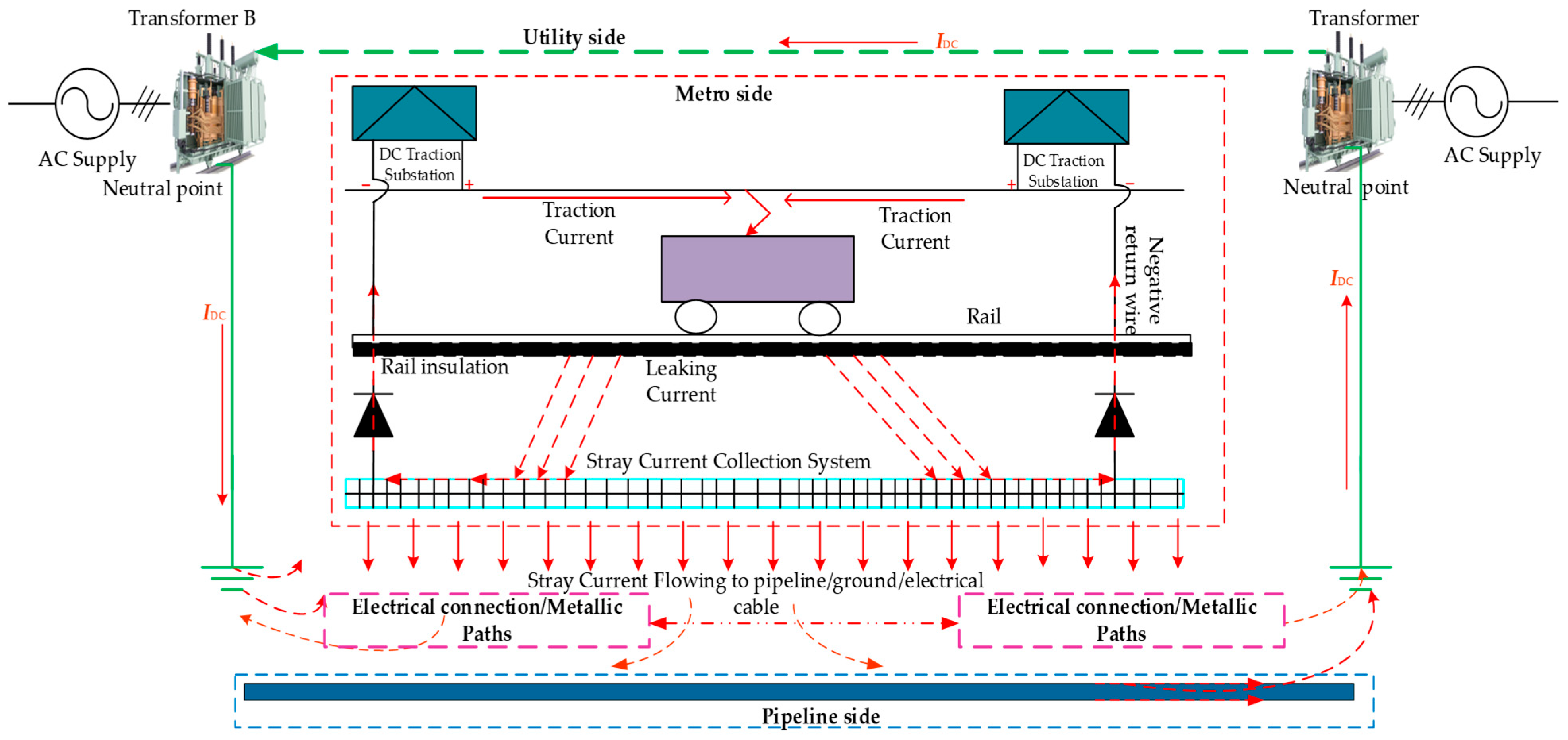
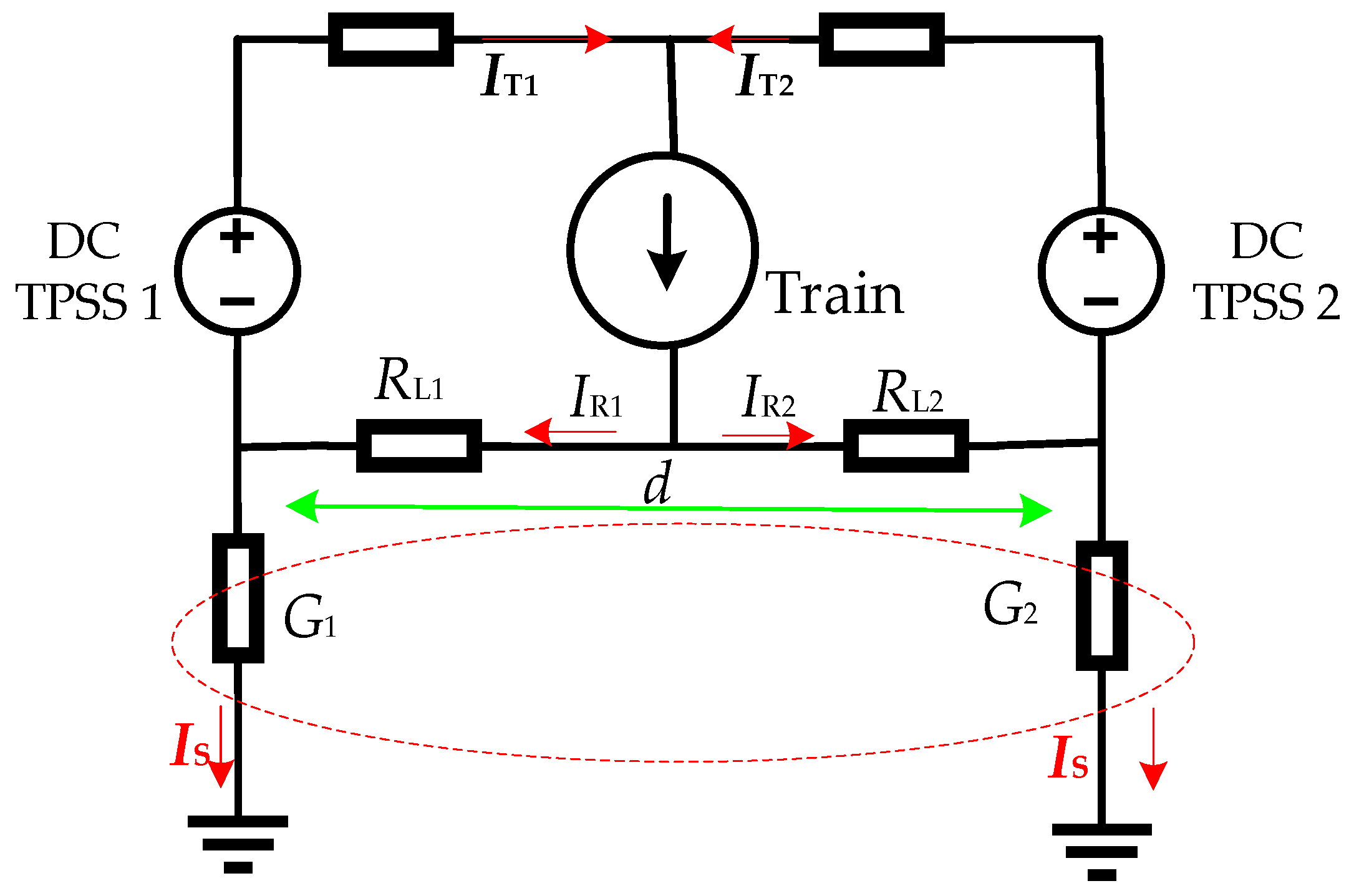

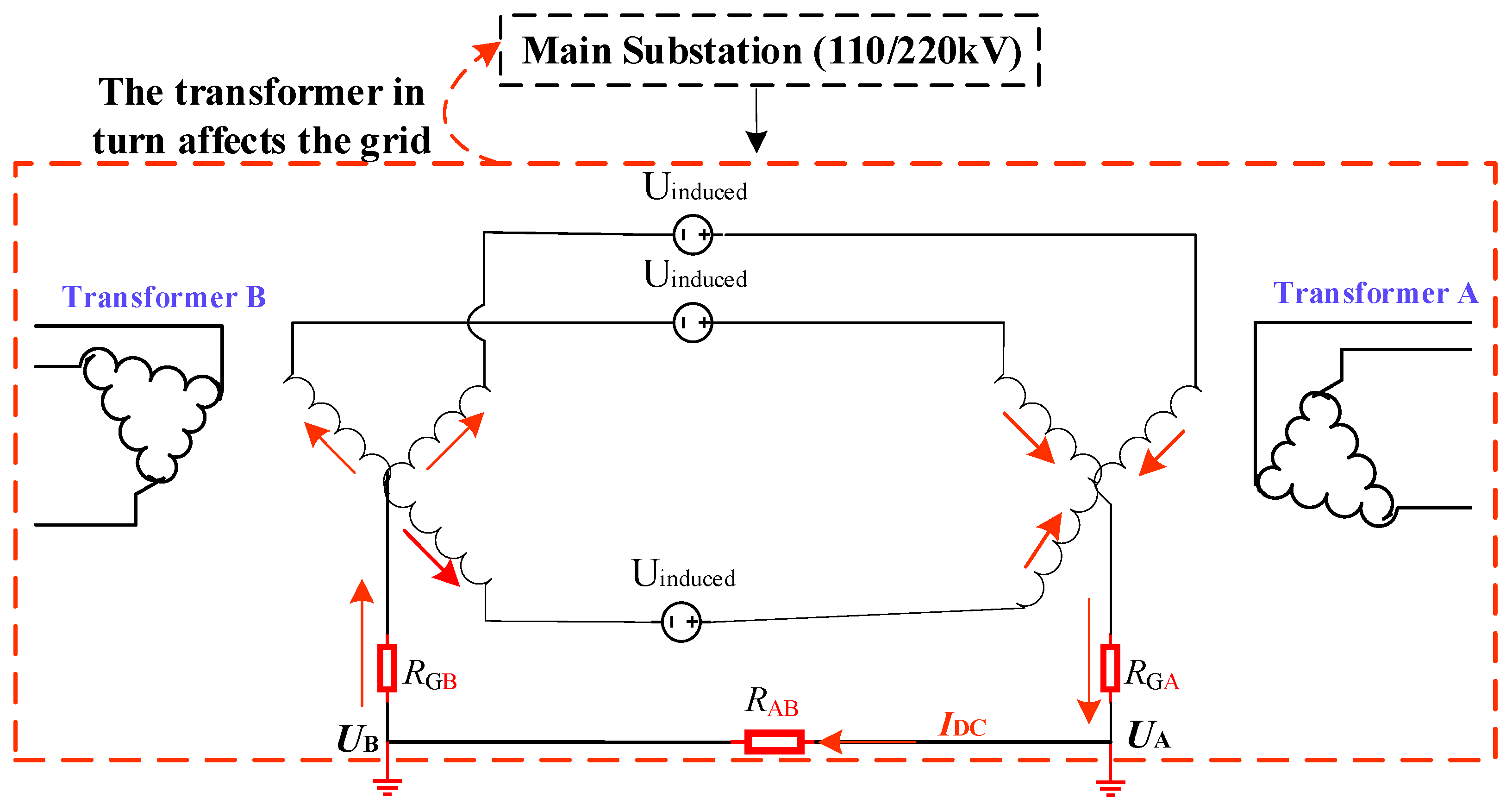
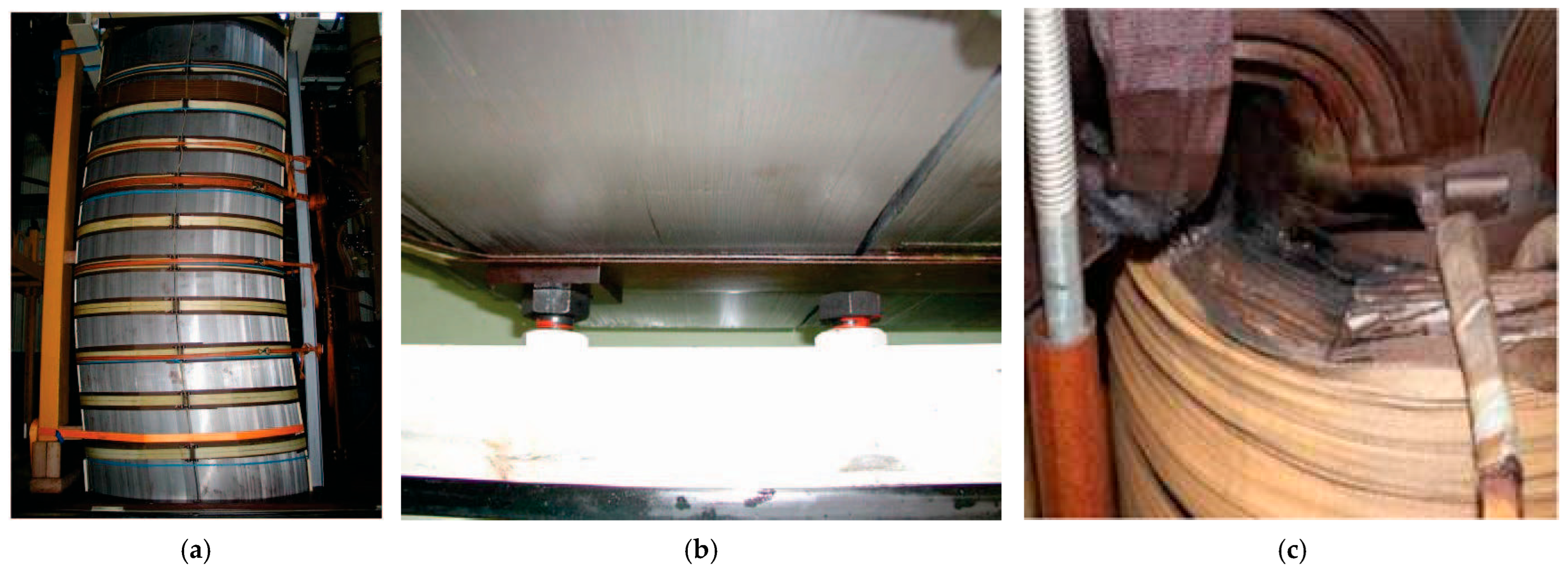
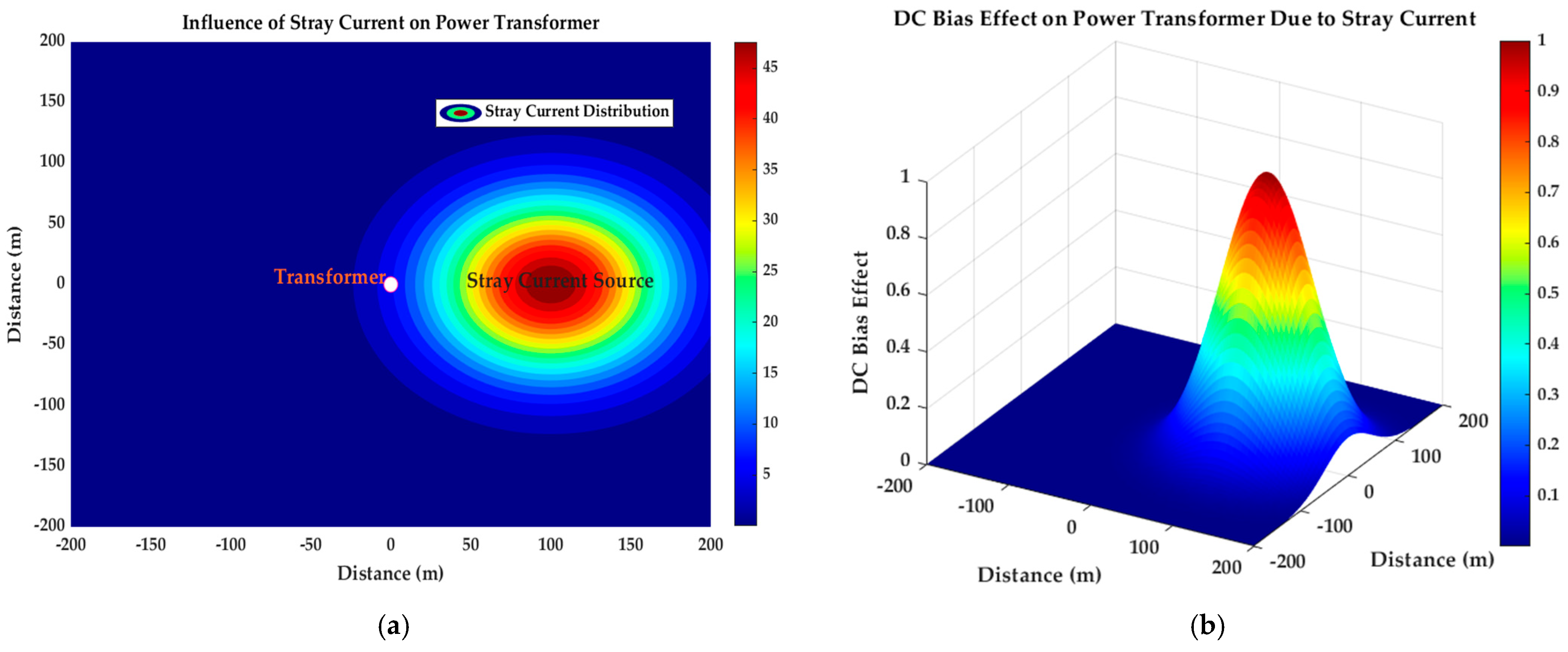
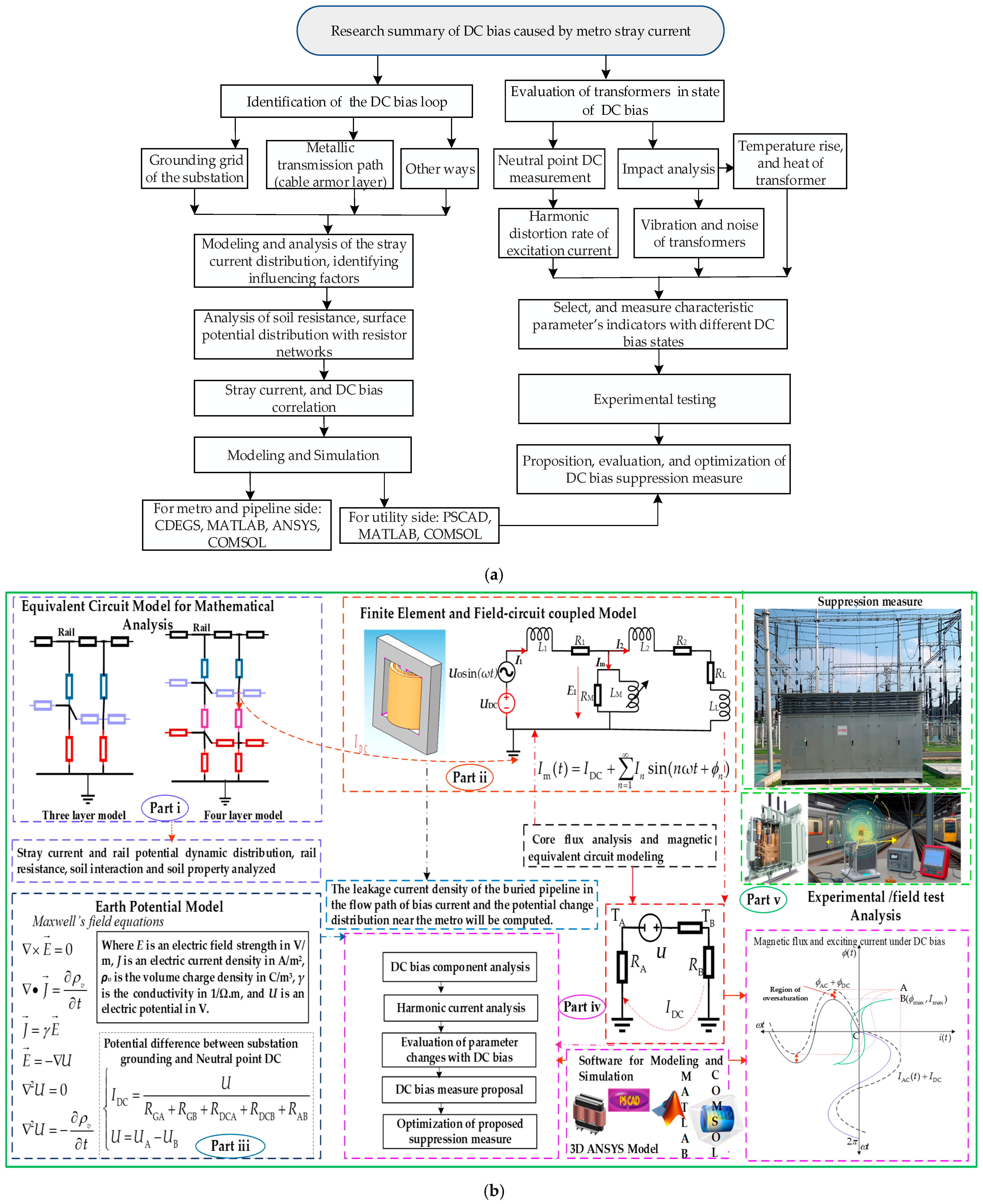

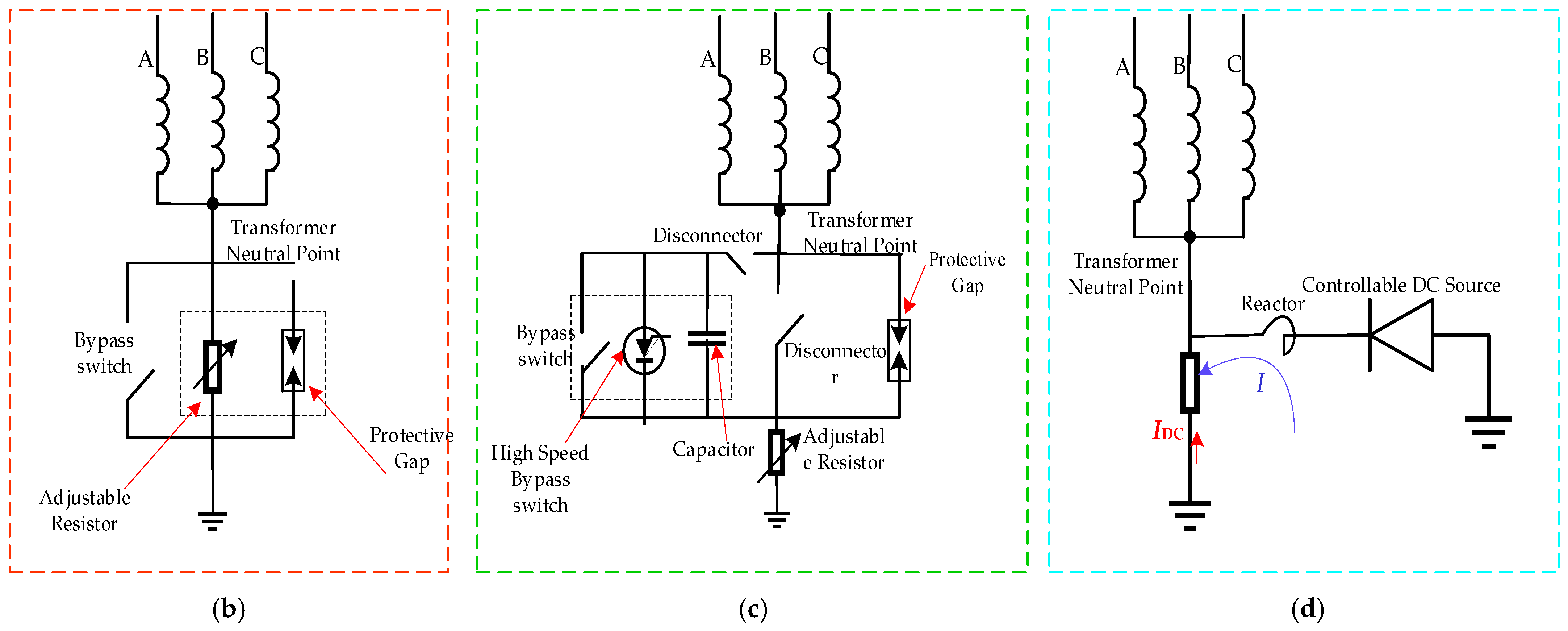
| Influence Areas | Challenges | Ref. |
|---|---|---|
| Metro side | Stray current is affecting nearby infrastructure and causing operational challenges | [10,11,12,13,16,17,18] |
| Insufficient insulation resulting in current leakage and rail potential hazards | [13,18] | |
| Pipeline side | Corrosion of buried metal pipelines due to stray current | [12,19,20,21,22,23] |
| Signal and communication interference effects | [15,24,25] | |
| Utility side | DC bias in utility transformers | [26,27,28,29,30,31,32,33,34,35] |
| Increased operational cost and reduced reliability of power distribution networks | [36,37] |
| Criteria | Blocking Capacitors | Limiting Resistors | Combined Device with a Capacitor and a Resistor | Reverse DC Injection |
|---|---|---|---|---|
| Effectiveness | It blocks the DC without affecting the AC flow, is reliable, provides high safety, has minimal impact on protection devices, but redistributes the residual DC. | It requires a protective gap, is ineffective for high DC bias values, and may cause excessive neutral voltage and insulation damage. | Better than resistors alone, avoids complete redistribution like capacitors. | Dynamic adjustment needed, compensated 80% of the DC. |
| Cost | Highly economical | Moderately higher cost | High cost (but avoid the extreme costs of reverse injection) | Very high (requiring auxiliary grounding, real-time control) |
| Applicability | Best for 220 kV and 500 kV utility transformers near the metro. | It is commonly used in low-voltage transformers. | Versatile (works in medium/high voltage transformers where pure capacitors/resistors are insufficient). | Limited to substations with independent grounding. |
| Threshold | Effective for DC > 4 A. | Effective for lower values of DC (higher resistance risks overvoltage), generally 3 Ω. | Balances blocking and limiting. | Requires precise matching of bias current (dynamic metro conditions challenge this). |
| Side effects | Overvoltage upon failure of the bypass, increasing the DC in the adjacent utility transformer. | Residual DC remains and alters the zero-sequence impedance. | More complex than standalone methods, requires careful tuning. | Complex control, higher power consumption, grounding grid burden. |
| Deployment strategy | Prioritize transformers supplying metro areas, and avoid clustering to prevent uneven current distribution. | Install widely in low-risk areas and recalibrate relay protections post-installation. | In substations needing both DC blocking/DC limiting. | Use sparingly, and integrate with real-time monitoring for dynamic compensation. |
| Field applications | Shenzhen (500 kV), Changsha 220 kV | Shanghai (500 kV) 3 Ω resistor reduced DC bias, HVDC projects | Emerging (limited field data, but promising in HVDC) | Wunan (500 kV), limited adoption due to cost and complexity |
| Key tradeoffs | High cost vs. complete DC blocking | Lower cost vs. partial suppression | Balanced performance vs. added complexity | High precision vs. impracticality for metros |
| Effectiveness rating | ★★★★☆ 1 | ★★★☆☆ 2 | ★★☆☆☆ 3 | ★☆☆☆☆ 4 |
Disclaimer/Publisher’s Note: The statements, opinions and data contained in all publications are solely those of the individual author(s) and contributor(s) and not of MDPI and/or the editor(s). MDPI and/or the editor(s) disclaim responsibility for any injury to people or property resulting from any ideas, methods, instructions or products referred to in the content. |
© 2025 by the authors. Licensee MDPI, Basel, Switzerland. This article is an open access article distributed under the terms and conditions of the Creative Commons Attribution (CC BY) license (https://creativecommons.org/licenses/by/4.0/).
Share and Cite
Makeyaw, A.; Yang, X.; Sun, X.; Liu, K.; Wu, T.; Chen, L. Utility Transformer DC Bias Caused by Metro Stray Current—A Review. Energies 2025, 18, 3678. https://doi.org/10.3390/en18143678
Makeyaw A, Yang X, Sun X, Liu K, Wu T, Chen L. Utility Transformer DC Bias Caused by Metro Stray Current—A Review. Energies. 2025; 18(14):3678. https://doi.org/10.3390/en18143678
Chicago/Turabian StyleMakeyaw, Adisu, Xiaofeng Yang, Xiangxuan Sun, Ke Liu, Tianyi Wu, and Lu Chen. 2025. "Utility Transformer DC Bias Caused by Metro Stray Current—A Review" Energies 18, no. 14: 3678. https://doi.org/10.3390/en18143678
APA StyleMakeyaw, A., Yang, X., Sun, X., Liu, K., Wu, T., & Chen, L. (2025). Utility Transformer DC Bias Caused by Metro Stray Current—A Review. Energies, 18(14), 3678. https://doi.org/10.3390/en18143678






